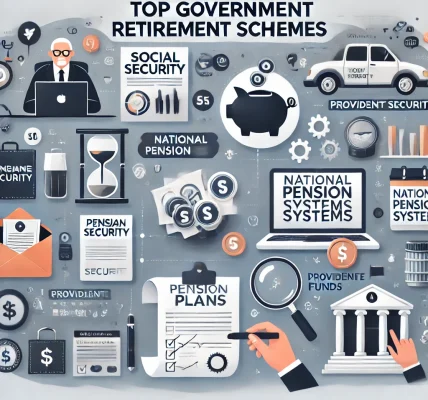Introduction
Planning for retirement requires strategic investment decisions to ensure financial stability during your golden years. A well-structured retirement portfolio should include a mix of growth and income-generating assets while balancing risk and reward. This article explores the top investment strategies that can help you achieve a secure retirement.
1. Start Early and Stay Consistent
One of the most effective retirement strategies is to start saving and investing early. The power of compound interest allows your money to grow exponentially over time. By consistently contributing to retirement accounts, such as a 401(k) or IRA, you can maximize your wealth accumulation.
Key Takeaways: ✅ Begin investing as soon as possible to take advantage of compounding interest. ✅ Make regular contributions to retirement accounts. ✅ Automate savings to ensure consistency.
2. Diversify Your Investment Portfolio
Diversification helps spread risk across different asset classes, reducing the impact of market volatility. A well-diversified portfolio typically includes a mix of:
📈 Stocks – High-growth potential but higher volatility. 📉 Bonds – Stable income source with lower risk. 🏠 Real Estate – Tangible asset with potential rental income. 🌍 International Investments – Exposure to global markets. 🏆 Alternative Assets – Gold, commodities, and cryptocurrencies can hedge against inflation.
Key Takeaways: ✅ Avoid putting all your money in one asset class. ✅ Balance risk and reward based on your age and risk tolerance. ✅ Rebalance your portfolio periodically.
3. Take Advantage of Tax-Advantaged Accounts
Tax-advantaged retirement accounts help reduce your tax liability while growing your investments. Consider these options:
🔹 401(k) or 403(b) – Employer-sponsored retirement plans with tax benefits. 🔹 Traditional IRA – Tax-deferred growth with pre-tax contributions. 🔹 Roth IRA – Tax-free withdrawals in retirement. 🔹 Health Savings Account (HSA) – A triple-tax-advantaged account for medical expenses.
Key Takeaways: ✅ Contribute enough to employer-sponsored plans to get the full employer match. ✅ Consider a Roth IRA for tax-free growth. ✅ Utilize an HSA for healthcare-related retirement expenses.
4. Invest in Dividend-Paying Stocks
Dividend stocks provide a consistent income stream in retirement while allowing capital appreciation. Companies with a strong dividend history offer stability and financial security.
Key Takeaways: ✅ Look for blue-chip stocks with a history of increasing dividends. ✅ Reinvest dividends to maximize compounding growth. ✅ Diversify across sectors to mitigate risk.
5. Consider Real Estate Investments
Real estate can be an excellent investment strategy for retirement, providing passive income and potential appreciation.
🏡 Rental Properties – Generate a steady income stream. 🏢 Real Estate Investment Trusts (REITs) – Invest in real estate without managing properties. 🏘️ House Hacking – Live in one unit while renting out the others.
Key Takeaways: ✅ Choose properties in high-growth areas. ✅ Consider REITs for easy diversification. ✅ Leverage rental income to cover retirement expenses.
6. Implement the 4% Withdrawal Rule
The 4% rule is a guideline for sustainable retirement withdrawals. It suggests withdrawing 4% of your portfolio annually, adjusting for inflation, to ensure your savings last throughout retirement.
Key Takeaways: ✅ Helps maintain financial security in retirement. ✅ Consider market conditions before withdrawing. ✅ Adjust spending if necessary during market downturns.
7. Hedge Against Inflation
Inflation can erode purchasing power over time, making it essential to invest in assets that keep pace with rising costs.
🔹 Stocks – Historically outpace inflation. 🔹 TIPS (Treasury Inflation-Protected Securities) – Adjust principal for inflation. 🔹 Commodities – Gold, oil, and other tangible assets provide inflation protection.
Key Takeaways: ✅ Include inflation-hedging investments in your portfolio. ✅ Monitor inflation trends and adjust accordingly. ✅ Maintain a mix of growth and income-generating assets.
8. Plan for Healthcare Costs
Healthcare expenses increase with age. Preparing for medical costs is essential for a secure retirement.
💊 Health Savings Account (HSA) – Offers tax-free withdrawals for qualified medical expenses. 🏥 Long-Term Care Insurance – Helps cover the cost of extended medical care. 📜 Medicare Planning – Understand coverage options and out-of-pocket costs.
Key Takeaways: ✅ Estimate future healthcare expenses. ✅ Maximize HSA contributions. ✅ Consider long-term care insurance.
9. Seek Professional Financial Advice
Consulting a financial advisor can help create a tailored retirement strategy based on your goals and risk tolerance.
Key Takeaways: ✅ Work with a fiduciary advisor to prioritize your interests. ✅ Review and adjust your investment strategy periodically. ✅ Stay informed about financial trends and economic changes.
Conclusion
A secure retirement requires careful planning, disciplined saving, and strategic investing. By implementing these investment strategies, you can build a robust financial foundation and enjoy peace of mind in retirement.




